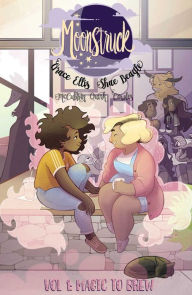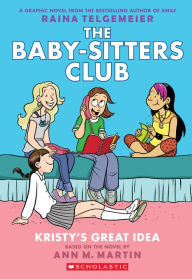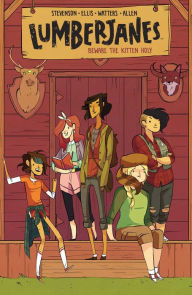Grace Ellis on the Werewolf Baristas and Proud Non-Binary Centaurs of Moonstruck
 Julie just wants to be a normal girl, with a normal girlfriend, working a normal barista job at the Black Cat Cafe. Which would all be easier if she weren’t a werewolf.
Julie just wants to be a normal girl, with a normal girlfriend, working a normal barista job at the Black Cat Cafe. Which would all be easier if she weren’t a werewolf.
Moonstruck Volume 1: Magic to Brew
Moonstruck Volume 1: Magic to Brew
By
Grace Ellis
Artist
Shae Beagle
,
Kate Leth
In Stock Online
Paperback $9.99
Well, more precisely, it would all be easier if she weren’t so hung up on being a werewolf. It would also make her crush/budding romance with Selena far less complicated. In the world of Moonstruck, from creators Grace Ellis and Shae Beagle, mythological creatures are just a part of everyday life. Her best pal and co-barista Chet is a non-binary centaur who’s perfectly comfortable with themself, even while Julie struggles with her own self-acceptance. There’s a magical conspiracy afoot, introduced by Julie’s clairvoyant friend Cass, but that’s almost secondary to the book’s slice-of-life feel. It’s a delightful story with a charming, diverse cast of characters, carried along by newcomer Beagle’s bright, confident, and playful art, and the delicate colors by Caitlin Quirk. It’s also unashamedly queer, celebrating being proud, out, and comfortable with yourself—whatever your gender identity, sexual orientation, skin tone, or body shape.
Well, more precisely, it would all be easier if she weren’t so hung up on being a werewolf. It would also make her crush/budding romance with Selena far less complicated. In the world of Moonstruck, from creators Grace Ellis and Shae Beagle, mythological creatures are just a part of everyday life. Her best pal and co-barista Chet is a non-binary centaur who’s perfectly comfortable with themself, even while Julie struggles with her own self-acceptance. There’s a magical conspiracy afoot, introduced by Julie’s clairvoyant friend Cass, but that’s almost secondary to the book’s slice-of-life feel. It’s a delightful story with a charming, diverse cast of characters, carried along by newcomer Beagle’s bright, confident, and playful art, and the delicate colors by Caitlin Quirk. It’s also unashamedly queer, celebrating being proud, out, and comfortable with yourself—whatever your gender identity, sexual orientation, skin tone, or body shape.
Writer Grace Ellis (Lumberjanes) was kind enough to chat with us about the book’s origins, queer representation in comics, The Baby-Sitters Club, and whether or not Moonstruck is, in fact a spin-off of the Cher/Nicolas Cage movie.
(Spoiler: It is not.)
I understand that the book came about via a class project for which you served as artist Shae Beagle’s mentor.
I was really luck to get paired up with Shae [for a project teaming pro writers and student artists]. It did feel like fate had intervened on our behalf, since we had basically the same haircut at the time, like we were definitely meant to be creative partners. But Shae is so smart, and they’re such a dynamic artist with such a unique sensibility, that I felt like they really understood what I was going for in that original comic. I would’ve had to be a real fool to turn down the chance to work with them more.
More specifically, what inspired the story?
Well, the [original] five-page story evolved out of wanting to do a story with multiple twists, and the twists were that an environment that most readers instantly recognize (a coffee shop) is not entirely what it seems (it’s full of magical creatures). When we decided to expand it, it was more about sitting down with the characters we already had and figuring out who they were beyond those five pages. Who is this werewolf who thinks of herself as a freak, despite living in a world of magic? And then thinking about stories that could only be told in this world, and adding additional characters that created interesting dynamics. I’m sorry, I know that’s a very writer-ly answer! I did put a lot of my own feelings and experiences into it as well (like a lot), but the foundation of the story was thinking about characters and identity and worldbuilding.
How does the book come together, in terms of process?
We like to have in-person meetings, which is pretty rare in comics. The ability to do that, I mean. But some of our best ideas have come from riffing together at coffee shops—the foundation of the second arc came out of a joke at a meeting. Generally, the process is pretty straight forward: I write a treatment of the arc, and then (editor) Laurenn McCubbin and Shae approve it, and then I write an individual issue outline, and then I write the issue once I have an idea of what needs to go on each page, more or less. And then it moves into Art World, and my understanding is that everyone [there] is a literal wizard, and suddenly my script is a thousand percent better because of what Shae and (letterer) Clayton Cowles and (colorist) Caitlin Quirk do to it.
Kristy's Great Idea (Full Color Edition) (The Baby-Sitters Club Graphix Series #1)
Kristy's Great Idea (Full Color Edition) (The Baby-Sitters Club Graphix Series #1)
Adapted by
Raina Telgemeier
By
Ann M. Martin
Illustrator
Raina Telgemeier
Paperback $10.99
The book-within-acomic Pleasant Mountain Sisters book series feels like a stand-in for those kids’ books that can be very…limited…in the range of characters they present. Were books like that important to you growing up (for good or for ill)?
Oh, definitely. I was really into the Baby-Sitters Club and Sweet Valley High as a kid, and I’ve always been into the idea of serialized YA books as a cultural touchstone, especially since so many kids read them and are familiar with them, but they aren’t often given credit as, like, a way kids learn about the world. And now we live in a world where Raina Telgemeier and co. have brought them to a new audience, and they’ve created an entire visual language in those books that we were able to use as a shorthand for our own book. In Moonstruck, we’re trying to use the Pleasant Mountain stories as a way to communicate information about the world of the book and about the characters. Julie is obsessed with them, and she holds them up as an ideal, but their world doesn’t look anything like hers. So part of the story is about considering how the media she consumes has shaped her as a person.
The book-within-acomic Pleasant Mountain Sisters book series feels like a stand-in for those kids’ books that can be very…limited…in the range of characters they present. Were books like that important to you growing up (for good or for ill)?
Oh, definitely. I was really into the Baby-Sitters Club and Sweet Valley High as a kid, and I’ve always been into the idea of serialized YA books as a cultural touchstone, especially since so many kids read them and are familiar with them, but they aren’t often given credit as, like, a way kids learn about the world. And now we live in a world where Raina Telgemeier and co. have brought them to a new audience, and they’ve created an entire visual language in those books that we were able to use as a shorthand for our own book. In Moonstruck, we’re trying to use the Pleasant Mountain stories as a way to communicate information about the world of the book and about the characters. Julie is obsessed with them, and she holds them up as an ideal, but their world doesn’t look anything like hers. So part of the story is about considering how the media she consumes has shaped her as a person.
Mainstream comics have had a rough time with queer themes and representations of body positivity for…pretty much ever. Books like this one remind me that things are changing. What are your thoughts on the state of the industry?
I agree with your take; I am optimistic about the industry changing for the better in terms of body positivity and queer representation. There are a lot of reasons to be optimistic: first of all, society as a whole is more positive about those issues (and others), so publishers are starting to acknowledge a market for books with those themes. I used to feel like you couldn’t turn the Titanic on a dime, and that the comics industry couldn’t be expected to suddenly become super progressive, but the longer I’ve been here and the more people I’ve worked with, I’m learning that actually, huge changes are entirely possible, as long as the right editors and writers are pushing for it. That’s not to say we’re going to see Superman kissing Batman next month or anything, but it’s not as ridiculous an idea as it might’ve been even a couple years ago.
Plus, I think we’re reaching a breaking point in the way the direct market itself functions, [one] that I hope will ultimately make diversity more palatable for publishers. But that’s a whole other in-the-weeds conversation.
Lumberjanes, Vol. 1: Beware the Kitten Holy
Lumberjanes, Vol. 1: Beware the Kitten Holy
By
ND Stevenson
,
Shannon Watters
,
Grace Ellis
Illustrator
Gus A Allen
In Stock Online
Paperback $14.99
Julie’s lack of comfort with her dual-nature reads like a metaphor for queer self-acceptance. Even with those deeper themes, the tone is fun and friendly and cute. Was it tough to keep that balance?
This question is so tough for me to answer because it really just flows so naturally that I’m not sure how we strike the balance that we do. I think for sure Shae’s art makes it seem a lot lighter than it might be otherwise. I just really want to tell a story with complicated characters living in a complicated world, but also I am pretty uninterested in writing a straight-up dramatic story, so this is where we landed. I try not to take myself too seriously, and I think that translates into characters who aren’t overly self-serious either.
Julie’s lack of comfort with her dual-nature reads like a metaphor for queer self-acceptance. Even with those deeper themes, the tone is fun and friendly and cute. Was it tough to keep that balance?
This question is so tough for me to answer because it really just flows so naturally that I’m not sure how we strike the balance that we do. I think for sure Shae’s art makes it seem a lot lighter than it might be otherwise. I just really want to tell a story with complicated characters living in a complicated world, but also I am pretty uninterested in writing a straight-up dramatic story, so this is where we landed. I try not to take myself too seriously, and I think that translates into characters who aren’t overly self-serious either.
I see that volume 2 is already solicited. What do we have to look forward to? Will we see Cher in future installments?
HA, can I just tell you that I had never seen the Cher movie until we started this book? I googled “Moonstruck” before I named our book, and I saw that it existed, but I assumed it was some unloved relic from the ’80s. That was… an incorrect instinct, I have learned. We did work in a very subtle, maybe too subtle, joke about it in the first arc, but it’s a Nic Cage joke, so we’ll have to work Cher into the next arc, I think.
Coming up on Moonstruck, you can expect more worldbuilding for sure. We’re really interested in expanding and exploring their city and the university, and we want to talk more about how magic functions in this world. The next arc is about the gang going to a fraternity party, but the fraternity is a group of fairies, and if you know anything about fairies in lore, you know they’re going to have to be pretty careful, since fairies are cunning. Spoiler alert: They are not careful enough.


